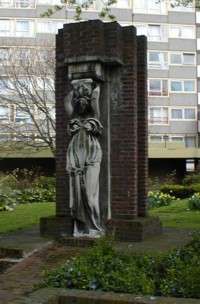Henry Poole (sculptor)

.jpg)
Henry Poole RA (28 January 1873 — 15 August 1928) was a British architectural sculptor.[1]
He studied at the Lambeth School of Art in 1888; and from 26 January 1892 under Harry Bates ARA and George Frederic Watts RA at the Royal Academy Schools.[2] Poole was elected ARA 22 April 1920 and became a full RA in 1927, shortly before his death. He exhibited at the Royal Academy between 1894 – 1928;[2] and was Master of the Sculpture School from 1921-1927.[1]
He worked for the army school of camouflage founded by Solomon Joseph Solomon, at Hyde Park during the First World War.[2]
Much of his architectural work has disappeared with the demolition of the buildings it decorated, but some examples survive. The celebrated bronze lions commissioned to guard The Bund entrance of The Hong Kong and Shanghai Banking Corporation's magnificent 1923 Shanghai office, still survive in the Shanghai History Museum. These were cast by J W Singer & Sons, in Frome, and modern replicas sit in their place outside the building on The Bund.
His statue of Edward VII, outside the Victoria Rooms in Bristol is another bronze survivor. As is the memorial to World War I fighter ace Albert Ball VC, DSO**, MC in the grounds of Nottingham Castle.
Carved stone works survive at Cardiff City Hall (Giraldus Cambrensis), Deptford Town Hall and Westminster Central Hall.
Works
- Deptford Town Hall (1903)
- Westminster Central Hall (1905–1911)
- Colnaghi's, New Bond Street (1912)
- Relief panels for the Public Library and Baths, Great Smith Street, (1892–1893)
- Edward VII memorial, Bristol (1913)
- Sculptures for the Chapel of St Michael and St George, St Paul's Cathedral
- Interior decoration of The Black Friar public house, Queen Victoria Street, London
- Evesham War Memorial, Evesham, Worcestershire (1921)
- Pudsey War Memorial, Pudsey, West Yorks (1922)
References
- 1 2 Henry Poole, R.A. (Royal Academy) accessed 1 October 2009
- 1 2 3 Young Pan, 1928 (Royal Academy) accessed 1 October 2009